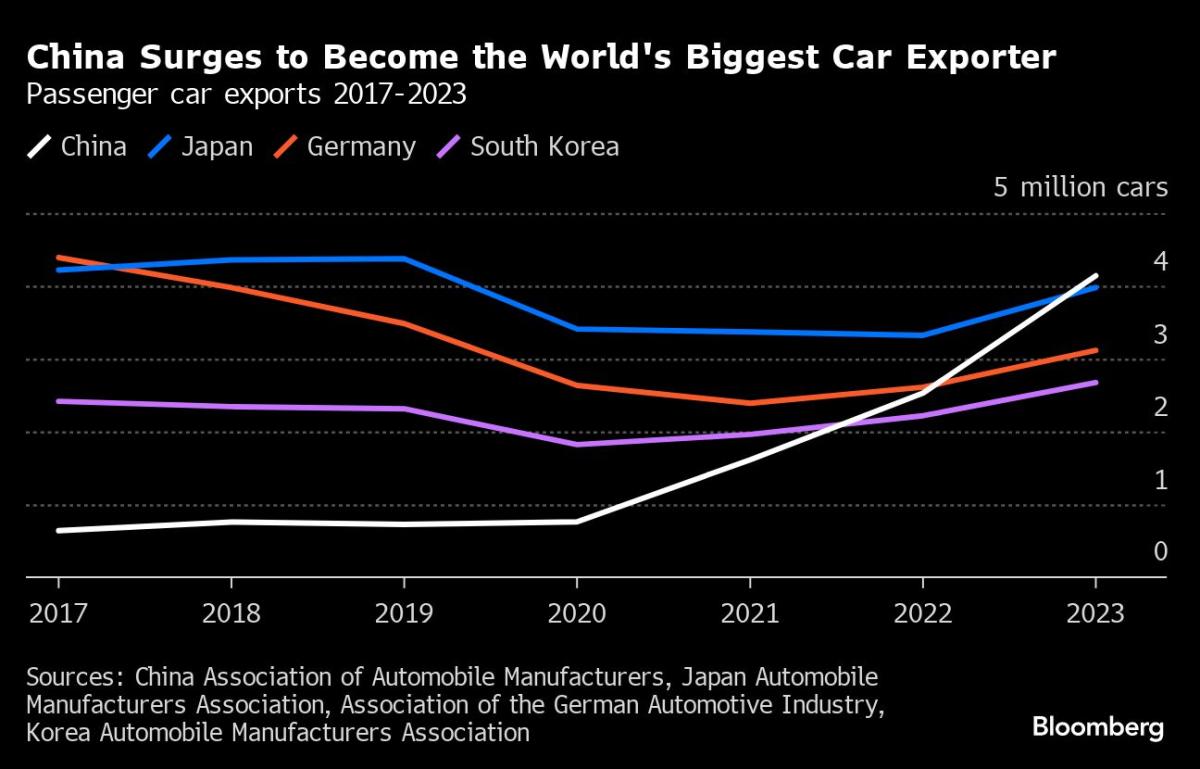(Bloomberg) — Ten years ago, almost to the day, as he surveyed a handful of luxury sedans from one of China’s largest automakers, SAIC Motor Corp., President Xi Jinping delivered a pivotal speech that would set China on course to electric car to dominate vehicle industry.
Most read from Bloomberg
The path to becoming a strong automaker lies in developing new energy vehicles, Xi said, according to a 2014 Xinhua report. Claiming an edge, or “high ground,” in this sector is key global competition, Xi said.
In 2014, China sold about 75,000 electric vehicles and hybrids, and exported about 533,000 cars. The domestic market was dominated by international manufacturers such as Volkswagen AG and General Motors Co., which were allowed to enter in the 1980s and 1990s by forming joint ventures with local players. This helped China transform from a cycling country to a driving country. Homegrown automakers and brands that did not work with foreign partners were seen as inferior and lagging behind in engine and other automotive technology.
To move forward and tackle environmental challenges, Beijing is focusing on fuel-efficient and alternative energy vehicles. The state had published a guideline in 2012 laying down ways to develop the industry by, among other things, setting sales targets, providing subsidies and allocating funds for building charging infrastructure. Xi’s speech two years later signaled China’s determination to use this as a way to leapfrog traditional Western and Asian auto powerhouses, especially Japan, home to Toyota Motor Corp.
Once ready, China needed a catalyst to stimulate consumer interest in electric vehicles, which in the early 2010s were mostly low-cost, short-range cars. That eventually became Tesla Inc., which became the first foreign automaker to set up its own subsidiary in China. With that special permission, Tesla completed its Shanghai factory in 2019. Entry into the market motivated local players to come up with better electric vehicles with longer range.
Fast forward to 2024, and China has become the world’s largest auto market, selling more electrified vehicles than any other country, with 9.5 million cars delivered last year. It also controls most of the battery supply chain. Homegrown champion BYD Co. dethroned Volkswagen to become the best-selling brand in China and surpassed Tesla as the world’s largest electric car maker in the last quarter of 2023. China also overtook Japan as the largest car exporter, sending 4.14 million units abroad, of which 1.55 million were electric vehicles or plug-in hybrids.
Read more: China’s stranglehold on the EV supply chain will be difficult to break
The results proved that Beijing’s industrial policies and investments were paying off. But they also increase tensions with the West. China’s success in electric cars, which could disrupt traditional automotive supply chains that employ millions of people, has become a major source of discomfort in Washington and Brussels.
As a price war at home and slowing growth push Chinese automakers to look elsewhere for buyers for their affordable and tech-laden electric cars, they are running into trade barriers, especially in the EU and the US, which are trying to find their own EV supply chains. Both have accused China of exporting its excess capacity.
The US has quadrupled tariffs on Chinese cars to more than 100%, while the EU is investigating Chinese EVs to see if there is an unfair advantage from government subsidies. Brazil recently removed a tax break on imported electric cars and even Russia, perhaps Beijing’s strongest ally and the biggest destination for Chinese car exports since the war with Ukraine, has asked Chinese automakers to localize production.
Beijing has threatened to hit back, with the Chinese Chamber of Commerce telling the EU on May 22 that import tariffs on cars with large engines could be increased from 15% to 25%. There is a June 5 deadline for the EU to notify Chinese EV exporters of preliminary findings and whether tariffs will be imposed.
SAIC, the state-owned manufacturer whose factory Xi visited a decade ago, happens to be one of three Chinese automakers, along with BYD and Zhejiang Geely Holding Group Co., selected for further investigation by the EU in its anti-subsidy probe. SAIC owns the British brand MG, one of the best-selling electric vehicles in Europe.
At an event marking the 10th anniversary of Xi’s speech on Friday, SAIC officials including chief engineer Zu Sijie said they have remembered the president’s instructions well, and that the company has consistently innovated in technologies such as smart driving and connected cars.
Li Zheng, the co-founder of SAIC Qingtao New Energy Technology Co., a battery startup backed by SAIC, took the opportunity to pledge that executives will not be complacent as electric vehicle competition increases, and noted that advances in solid-state batteries, which have higher energy density and lower fire risk, will be one way for China to maintain its lead.
“New energy vehicles have become a strategic industry, fiercely opposed by countries around the world,” Li said. “They are an important supporting force for the revitalization of the green sectors in our country.”
A lot can happen in a decade, but with SAIC investing around 150 billion yuan ($21 billion) in research and development in the past decade alone, 2034 looks bright despite trade wars.
–With help from Jinshan Hong.
Most read from Bloomberg Businessweek
©2024 BloombergLP







